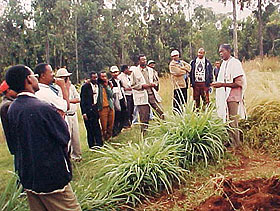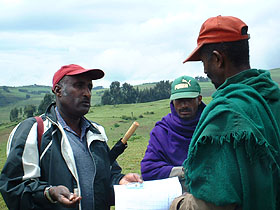 |
||||||||||||||||||||||||||||||||
Ethiopia
Highly intensified enset-tuber-cereal systems This Areka Research sub-station of Awassa Agricultural Research Center (ARC) has a young group of scientists from several disciplines: crop agronomy, economics, agroforestry, soils and has inputs from Awassa College, a PhD student and ARC and CIAT, TSBF, ILRI and Norwegian Agricultural University. They work closely with extension and several NGOs. Work commenced in 1999 and they have had success in their work with farmers. There are some links with ECABREN, the bean network. This is the most poverty stricken and distant site from major markets. There are very small land sizes (0.5 ha for a family of 6). Soils are very poor in N and P and erodible. There is fuel wood shortage, extreme food shortage and lack of cash in the system. The farming system is diverse: maize, teff and sorghum, sweet potatoes, beans, enset, a small amount of coffee and local spices. Livestock is important but only owned by 10% of the households. There are 6 ways to share a large animal (ox), where manure, power and the symbol of wealth are highly valued. Livestock are currently grazed in valley bottoms or tethered. Inputs have been supplied and subsidized by the government but now this system has been changed, so inputs are no longer easily affordable. Without fertilizer, there is no crop in the outfields, so farmers have a renewed interest in inorganic materials for soil fertility management. Researchers started working with farmers to improve the crop system by introducing improved varieties (maize, wheat, teff, beans, sweet potato, and others). This has then brought in the issue of seed supplies and work has commenced to test two different informal seed systems for several crops. Research and farmers have identified promising forage species so as to intensify the feed system. Various technologies are under test to improve soil fertility (boundaries, intercropping, relay cropping, mulch) and banana, fodder and trees are integrated with conservation structures. Work has just started on liming with other soil amendments. Farmer requests are for improved grain storage to allow them to speculate on the market; credit to buy livestock, implements and inputs. They are also keen to develop the local policy dimension of the work. Farmer research groups have started in 2000 after long discussions and waiting for farmers to reach a decision to form these. Links with the district authorities are strong. Systems agronomist regional research fellow (under CIAT) has worked in both Areka and Ginchi: (1) developing a model to understand risk, seasonality and land use options in relation to food quantity and quality, feed and soil fertility. (2) spatial and temporal use of legume species and trade-offs (3) maize varietal mixtures to avoid risk and increase options. NRM issues include:
The farming system is primarily barley with rye coming in and fallow with extensive livestock grazing. Potatoes and enset are grown near the homestead. There are few trees and extreme climate (wind, frost, long dry season), shrinking grazing land, little system diversification and almost no soil conservation in evidence. Livestock feed and diseases are also important limitations. This site is indicative of a large area of the Ethiopian highlands which are by-and-large cereal-livestock dominated. The landscape has undulating hills and valleys forming many micro-watersheds. Strategies to improve this system have been targeted first to fields near the homestead, while working on potential species that can be used to intensify management of the grazing land at a later stage. The current work is on maintaining and improving a major food and cash source (potatoes) where varietal improvement, integrated disease management and better husbandry, including soil fertility. Work on compost and manure management has started. The team plans to look into options to diversify and that are market oriented have been topics for experimentation with farmers input. The team would like to try enclosing some of the open cereal land with fodder trees or useful shrubs/ tress. Inside these areas one can then use improved fallow species to increase soil fertility. This first requires some testing of species, farmer assessment and work with farmers on larger scale land and water management. Given the communal management of some land during some time periods and individual farming at other periods, management changes in the landscape will take some time. Much of the research was initially done on the research station, but was found to have limited relevance given the different environment to this area. There is now more emphasis and appreciation for involving farmers in the research process directly. Farmer research groups were formed this year and are recipients of a farmer field school approach targeting at this time IPM. Watershed work is commencing this year. NRM issues include:
|
||||||||||||||||||||||||||||||||

